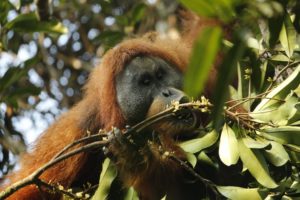
An orangutan from the Batang Toru region of the island of Sumatra in Indonesia, which researchers say is a distinct, third species of great apes. Credit Tim Laman.
Jakarta, MINA – Researchers have announced the discovery of a new orangutan species — Tapanuli orangutan (Pongo tapanuliensis) — in the north of Sumatra Island.
The Tapanuli orangutan thus becomes the first new addition in almost a century to the small club of great apes, joining its fellow Sumatran and Borneo orangutans, gorillas, bonobos, chimpanzees, and humans.
“Unfortunately, threats, including deforestation and fires, mean that any new species discovered in Indonesias forests will struggle to survive. Although Indonesian biodiversity continues to surprise us, so does the lack of real protection it gets from the government,” Antara News repoted, quoting Ratri Kusumohartono, Greenpeace Indonesia forest campaigner, in a press statement, Monday.
The population of genetically and morphologically unique Tapanuli orangutans is estimated at fewer than 800 remaining, concentrated in a small number of forest fragments, totaling 1,000 square kilometers in the districts of Central, North, and South Tapanuli.
Also Read: AWG Endorses Jusuf Kalla to Lead Interim Gaza Government, Rejects Trouble Maker Tony Blair
Their hilly habitat is threatened by industrial and agricultural development, including a proposed hydroelectric development that could impact up to eight percent of their remaining heartland, researchers claim.
Last August, the Environment and Forestry Ministry of Indonesia had published a study on Borneo and Sumatra orangutans that confirms numbers have plummeted since the last survey was conducted in 2004 and established habitat destruction as one of the main causes.
Borneo orangutans are currently believed to number only an estimated 0.13 to 0.47 per square kilometer within their range, down from the 2004 estimated density of some 0.45 to 0.76 per square kilometer.
“Companies continue to develop palm and pulp plantations in forests and peatland areas that are some of the last homes for orangutans. The few remaining orangutan strongholds, such as the forests in Batang Toru, in Sumatra, and Sungai Putri, in Kalimantan, must be completely off industry limits if we want to save Indonesias most iconic animal species,” she remarked.
Also Read: Viral Xpose Broadcast on Trans7: NU Chairman Says It Openly Insults Pesantren
Tapanuli orangutans were only “discovered” by scientists in the late 1990s. In their recently published description of the new species, researchers used genetic comparison to estimate they split from Sumatran orangutans to their north as long ago as 3.38 million years ago. The newly recognized Tapanuli orangutan has a different diet, call, differently sized & shaped skull, and different hair color and pattern, among other unique aspects of behavior and appearance. (T/RS5/RS1)
Mi’raj Islamic News Agency (MINA)
Also Read: Indonesia Reaffirms Its Commitment to Becoming a Global Leader in Herbal Medicine






























 Mina Indonesia
Mina Indonesia Mina Arabic
Mina Arabic